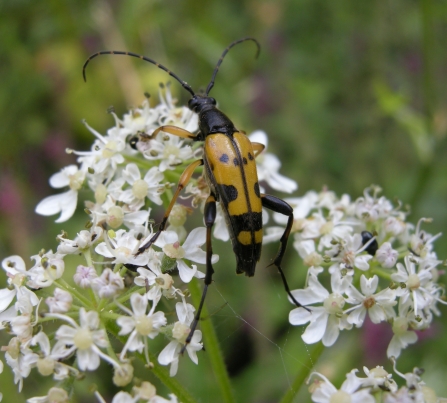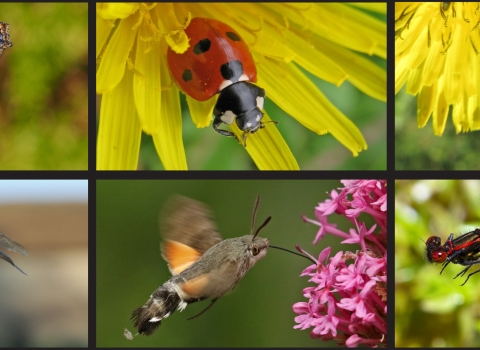This time of year is a great time to start looking for insects on flower heads. I’m lucky enough to have a field on my doorstep that I visit on my daily walks and two of the flowers that are currently blooming and attracting lots of insects are the ox-eye daisies and hogweed. At the moment as I scan the flowers I’m spotting numerous little longhorn beetles going about their business, feeding and mating.
Lovely longhorns
Fairyring longhorn beetles by Jean Young

Black and yellow longhorn beetle by Jean Young
They are known as longhorn beetles because of their long antennae. Most species are associated with dead wood, where the larvae develop, and a couple of species use the stems of herbaceous plants. However, the longhorn I’ve been seeing lots of is called the fairy-ring longhorn Pseudovadonia livida and is a little unusual as it is associated with the fairy-ring fungi Marasmius oreades that's found in grasslands.
The beetles are quite small, 5-9mm long (not including antennae), and the wing cases are a tan/brown colour. The field I have been exploring has a lot of fairy-rings, so many that you can even spot them in aerial photos, and as a result there is a very healthy population of these beetles. I had wondered if the wet winter would knock back their numbers as they overwinter in the soil and the field was waterlogged for months. However last weekend there was a large emergence so it is good to see they can cope with the vagaries of the British weather!
The longhorn beetles are a lovely group and come in a variety of sizes and many are very attractively patterned, which makes them a good family to start with if you want to learn to identify a few beetles. Some of the quite distinctive ones to look out for that I’ve come across feeding on hogweed or ox-eye daisies are the wasp beetle Clytus arietis (6-15mm), the black and yellow longhorn Rutpela maculata (13-20mm) and the black-striped longhorn Stenurella melanura (6-10mm).
So keep your eyes peeled when you’re out and about and see what you can find. If you are lucky enough to spot any longhorn beetles you could submit a record of your sighting to Worcestershire Biological Records Centre. Sending a photo and details of what you found and where and when you saw it is a great way of helping us understand how our wildlife is doing and where it can be found.







